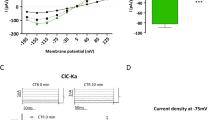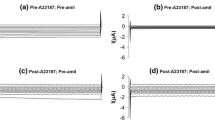Abstract
Despite the recognized role of bradykinin (BK)-induced calcium and chloride conductance in regulating salt transport in the kidney, the signaling pathway involved has not been well examined. Patch clamp of murine proximal tubule (TKPTS) cells revealed that BK (10 nM) produced an increase in an outwardly rectifying current from a basal level of 2.9 ± 0.6 to 13.8 ± 1.1 pA/pF following addition of BK (n = 8; p < 0.001). The shift in reversal potential seen with BK on changing the intracellular solution to 152 mM chloride and significant inhibition of the current by 100 μM 4,4′-di-isothiocyanato-stilbene-2,2′-disulphonic acid (DIDS) suggested that BK activated a chloride current. BK-induced current was blocked by B2 receptor antagonist but not by B1 antagonist or pertussis toxin indicating that the current was mediated by B2 receptors possibly through Gq activation. TMB-8 completely blocked the BK-calcium rise in fura-2 studies but did not block the BK-chloride response indicating that BK-mediated chloride current is calcium-independent. BK-induced current was dependent on phospholipase C (PLC) since U73122, a PLC-β blocker (10 μM) blocked it completely. Furthermore, chloride conductance was not modulated by bisindolylmaleimide, an inhibitor of protein kinase C (PKC), but was enhanced by dibutyryl cAMP. We conclude that BK-induced rise in chloride current is mediated by B2 receptors and dependent on PLC activation but not dependent on calcium rise. Furthermore, the current can be modulated by cAMP but not PKC.
Similar content being viewed by others
Abbreviations
- BK:
-
Arg-Pro-Pro-Gly-Phe-Ser-Pro-Phe-Arg)
- U-73122:
-
1-[6-[[17 beta-3-methoxyestra-1,3,5(10)-trien-17-yl]amino]hexyl]-1H-pyrrole-2,5-dione
- DIDS:
-
4,4′-di-isothiocyanato-stilbene-2,2′-disulphonic acid
- BIM:
-
bisindolylmaleimide
- TMB-8:
-
8-(N,N-diethylamino)octyl-3,4,5-trimethoxybenzoate hydrochloride
- PLC:
-
phospholipase C
References
Mattson DL, Cowley AWJ (1993) Kinin actions on renal papillary blood flow and sodium excretion. Hypertension 21: 961–965
Fenoy FJ, Roman RJ (1992) Effect of kinin receptor antagonists on renal hemodynamic and natriuretic responses to volume expansion. Am J Physiol 262: R1136–R1140
Casarini DE, Boim MA, Stella RCR, Schor N (1999) Endopeptidases (kininases) are able to hydrolyze kinins in tubular fluid along the rat nephron. Am J Physiol 276: F66–F74
Tomita K, Pissano JJ, Burg MB, Knepper MA (1986) Effects of vasopressin and bradykinin on anion transport by the rat cortical collecting duct Evidence for an electroneutral sodium chloride transport pathway. J Clin Invest 77: 136–141
Mukai H, Fitzgibbon WR, Bozeman G, Margolius HS, Ploth DW (1996) Bradykinin B2 receptor antagonist increases chloride and water absorption in rat medullary collecting duct. Am J Physiol 271: R352–R360
Grider J, Falcone J, Kilpatrick E, Ott C, Jackson B (1995) Effect of bradykinin on NaCl transport in the medullary thick ascending limb of the rat. Eur J Pharmacol 287: 101–104
Tamma G, Carmosino M, Svelto M, Valenti G (2005) Bradykinin signaling counteracts cAMP-elicited aquaporin 2 translocation in renal cells. J Am Soc Nephrol 16: 2881–2889
Kose H, Boese SH, Glanville M, Gray MA, Brown CD, Simmons NL (2000) Bradykinin regulation of salt transport across mouse inner medullary collecting duct epithelium involves activation of a Ca(2+)-dependent Cl(−) conductance. Br J Pharmacol 131: 1689–1699
Lal MA, Kennedy CR, Proulx PR, Hebert RL (1997) Bradykinin-stimulated cPLA2 phosphorylation is protein kinase C dependent in rabbit CCD cells. Am J Physiol 273: F907–F915
Siragy HM, Jaffa AA, Margolius HS (1997) Bradykinin B2 receptor modulates renal prostaglandin E2 and nitric oxide. Hypertension 29: 757–762
Bae HR, Verkman AS (1990) Protein kinase A regulates chloride conductance in endocytic vesicles from proximal tubule. Nature 348: 637–639
Planelles G (2004) Chloride transport in the renal proximal tubule. Pflugers Arch 448: 561–570
Darvish N, Winaver J, Dagan D (1994) Diverse modulations of chloride channels in renal proximal tubules. Am J Physiol 267: F716–F724
Oh EJ, Weinreich D (2004) Bradykinin decreases K(+) and increases Cl(−) conductances in vagal afferent neurones of the guinea pig. J Physiol 558: 513–526
Tiwari MM, Prather PL, Mayeux PR (2005) Mechanism of bradykinin-induced Ca2+ mobilization in murine proximal tubule epithelial cells. J Pharmacol Exp Ther 313: 798–805
Ernest S, Bello-Reuss E (1995) Expression and function of P-glycoprotein in a mouse kidney cell line. Am J Physiol 269: C323–C333
Arany I, Megyesi J, Kaneto H, Tanaka S, Safirstein RL (2004) Activation of ERK or inhibition of JNK ameliorates H2O2 cytotoxicity in mouse renal proximal tubule cells. Kidney Int 65: 1231–1239
Di Mari JF, Davis R, Safirstein RL (1999) MAPK activation determines renal epithelial cell survival during oxidative injury. Am J Physiol 277: F195–F203
Grynkiewicz G, Poenie M, Tsien RY (1985) A new generation of Ca2+ indicators with greatly improved fluorescence properties. J Biol Chem 260: 3440–3450
Stimers JR, Liu S, Kinard TA (1993) Effect of Nai on activity and voltage dependence of the Na/K pump in adult rat cardiac myocytes. J Membrane Biol 135: 39–47
Smith RJ, Sam LM, Justen JM, Bundy GL, Bala GA, Bleasdale JE (1990) Receptor-coupled signal transduction in human polymorphonuclear neutrophils: effects of a novel inhibitor of phospholipase C-dependent processes on cell responsiveness. J Pharmacol Exp Ther 253: 688–697
Kremer SG, Breuer WV, Skorecki KL (1989) Vasoconstrictor hormones depolarize renal glomerular mesangial cells by activating chloride channels. J Cell Physiol 138: 97–105
Shuprisha A, Lynch RM, Wright SH, Dantzler WH (2000) PKC regulation of organic anion secretion in perfused S2 segments of rabbit proximal tubules. Am J Physiol 278: F104–F109
Park SH, Lee YJ, Lim MJ, Kim EJ, Lee JH, Han HJ (2004) High glucose inhibits fructose uptake in renal proximal tubule cells: involvement of cAMP, PLC/PKC, p44/42 MAPK, and cPLA2. J Cell Physiol 200: 407–416
Kremer SG, Zeng W, Hurst R, Ning T, Whiteside C, Skorecki KL (1995) Chloride is required for receptor-mediated divalent cation entry in mesangial cells. J Cell Physiol 162: 15–25
Kremer SG, Zeng W, Sridhara S, Skorecki KL (1992) Multiple signaling pathways for Cl(-)-dependent depolarization of mesangial cells: role of Ca2+, PKC, and G proteins. Am J Physiol 262: F668–F678
Smith RJ, Iden SS (1979) Phorbol myristate acetate-induced release of granule enzymes from human neutrophils: inhibition by the calcium antagonist, 8-(N,N-diethylamino)-octyl 3,4,5-trimethoxybenzoate hydrochloride. Biochem Biophys Res Comm 91: 263–271
Ling BN, Kokko KE, Eaton DC (1994) Prostaglandin E2 activates clusters of apical Cl− channels in principal cells via a cyclic adenosine monophosphate-dependent pathway. J Clin Invest 93: 829–837
Poncet V, Tauc M, Bidet M, Poujeol P (1994) Chloride channels in apical membrane of primary cultures of rabbit distal bright convoluted tubule. Am J Physiol 266: F543-F553
Husted RF, Volk KA, Sigmund RD, Stokes JB (1995) Anion secretion by the inner medullary collecting duct Evidence for involvement of the cystic fibrosis transmembrane conductance regulator. J Clin Invest 95: 644–650
Dean R, Maric C, Aldred GP, Casley D, Zhuo J, Harris P, Alcorn D, Mendelsohn FA (1999) Rat renomedullary interstitial cells possess bradykinin B2 receptors in vivo and in vitro. Clin Exp Pharmacol Physiol 26: 48–55
Seki G, Taniguchi S, Uwatoko S, Suzuki K, Kurokawa K (1995) Activation of the basolateral Cl− conductance by cAMP in rabbit renal proximal tubule S3 segments. Pflugers Arch 430: 88–95
Mitchell CH, Zhang JJ, Wang L, Jacob TJ (1997) Volume-sensitive chloride current in pigmented ciliary epithelial cells: role of phospholipases. Am J Physiol 272: C212–C222
Aboolian A, Molen MV, Nord EP (1989) Differential effects of phorbol esters on PGE2 and bradykinin-induced elevation of [Ca2+]i in MDCK cells. Am J Physiol 256: F1135–F1143
Steidl M, Ritter M, Lang F (1991) Regulation of potassium conductance by prostaglandins in cultured renal epitheloid (Madin-Darby canine kidney) cells. Pflugers Arch 418: 431–436
Tewari KP, Malinowska DH, Sherry AM, Cuppoletti J (2000) PKA and arachidonic acid activation of human recombinant ClC-2 chloride channels. Am J Physiol 279: C40–C50
Acknowledgements
This research was supported by funds from the UAMS Graduate Student Research Fund awarded to M.M. Tiwari.
Author information
Authors and Affiliations
Corresponding author
Rights and permissions
About this article
Cite this article
Tiwari, M.M., Stimers, J.R. & Mayeux, P.R. Bradykinin-induced chloride conductance in murine proximal tubule epithelial cells. Mol Cell Biochem 297, 1–8 (2007). https://doi.org/10.1007/s11010-006-9315-3
Received:
Accepted:
Published:
Issue Date:
DOI: https://doi.org/10.1007/s11010-006-9315-3




